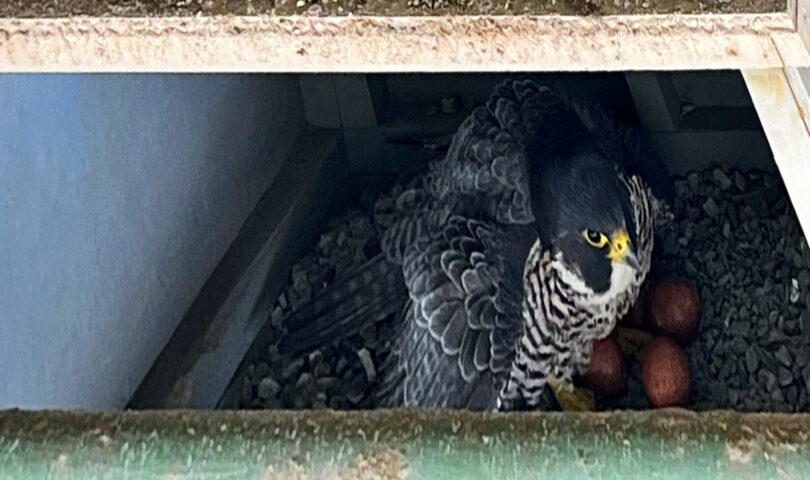Fast facts:
– A pair of peregrine falcons have returned to the Sault Ste. Marie International Bridge this spring, where the birds have been returning for years. This year, they have laid four eggs in a nest box on the Canadian side of the bridge.
– While a live video stream of the U.S. side nest box is viewable at www.saultbridge.com/falcam, there is no camera on the Canadian nest box.
– The peregrine falcon has been removed from the U.S. federal endangered species list but is listed as an endangered species in Michigan.
SAULT STE. MARIE, Mich. and Ontario – A pair of nesting peregrine falcons is back this spring at the Sault Ste. Marie International Bridge, but they may have changed their citizenship. This year, the raptors set up house on the Canadian side of the span.
Karl Hansen, bridge engineer for the International Bridge Administration (IBA), reports that a pair of peregrines has laid four eggs in the Canadian side nest box. It’s not currently known if it is the same pair that has nested on the bridge between the U.S. and Canada for years.
Nest boxes for the peregrines have been installed on the bridge since 2010, placed at locations that had evidence of past nesting activity. Last year, the resident pair of peregrine falcons hatched two chicks. Over the years, the site has been great success, hatching 35 falcon chicks since IBA staff started counting the birds, Hansen said.
“Since both nest boxes were installed, the birds had never nested in the Canadian box, as far as we’re aware,” Hansen said.
Several years ago, the IBA added a video camera trained on the U.S. side nest box, the “FalCam.” The live video stream, which has become very popular, is viewable at www.saultbridge.com/falcam. Normally, it offers bird watchers a front row seat for the seasonal activities of the endangered raptors, but this year it is showing an empty nest.
“We humans have no control over where these birds choose to nest,” Hansen pointed out.
A team from the Michigan Department of Natural Resources (DNR) typically bands the birds at the IBA mid-summer. Color-coded bands attached to the legs of young birds allow scientists to track the movements, reproductive behavior, and population growth of the falcons. This year the IBA and the DNR will be monitoring the peregrines in collaboration with the Ontario Ministry of Natural Resources and Forestry.
Michigan lost its peregrine falcons in the 1960s and 1970s due to the use of DDT and other environmental contaminants. Since conservation efforts started in the mid-1980s, the number of peregrines has fluctuated, but has generally increased since the 1990s, according to the MDNR.
The peregrine falcon has been removed from the federal endangered species list but is listed as an endangered species in Michigan, protected by state and federal law. While they historically nested on cliff faces in Michigan, peregrines have adapted well to city habitats, nesting on tall buildings, smokestacks, bridges, and other man-made structures around the world.
In Canada, peregrine populations have also increased in recent years. Federally, the species is designated “not at risk” in Canada, except for one subspecies listed as of “special concern.” on the federal Species at Risk Act.
Of all the active peregrine falcon nesting sites monitored by the MDNR in the Upper Peninsula, the International Bridge is the second most productive in terms of chicks hatched, behind only a nest on Grand Portal Cliff at Pictured Rocks National Lakeshore.
High-speed hunters capable of flying at 200 mph, the peregrines may help keep populations of nuisance pigeons under control. While researchers have found pigeons make up a relatively small portion of the falcon diet, the dangerous predators may play a role in frightening them away from bridges. Keeping pigeons away is seen as potentially saving the IBA maintenance money down the line, as pigeon droppings can damage paint on metal bridge surfaces.
- Prosecutor Issues Statement Regarding Local Sex Crime Trial - May 8, 2024
- 17 th Annual Sven Heikkinen Memorial Golf Tournament - May 8, 2024
- Senate Introduces Prison Productivity Credit Package - May 8, 2024




